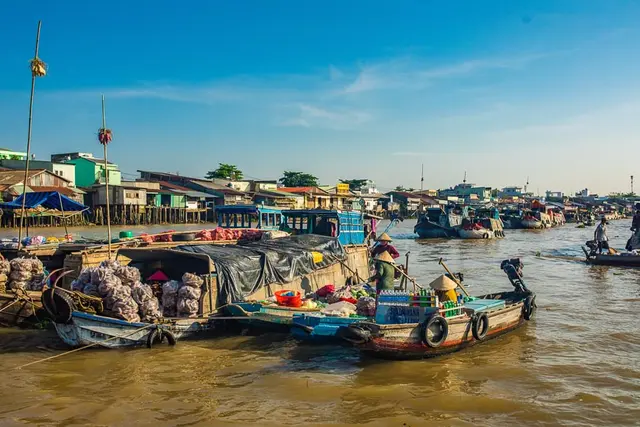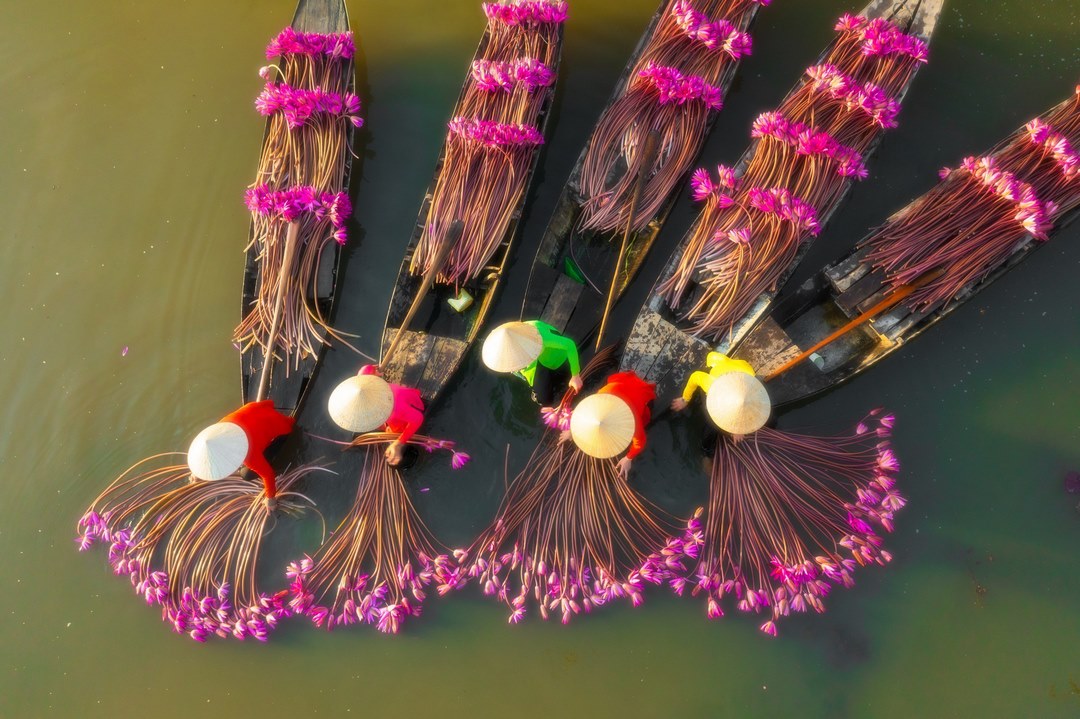This guide displays some of the highlights Mekong Delta facts. Hello, are you searching for mekong delta interesting facts? The Mekong Delta is a vast part of Vietnam that is varied in geography, natural occurrences, and history. Here’s a brief list of notable information about the area. We stick to some general facts plus information about its wartime past and the annual flood season.
Key Information and General Mekong Delta Facts
Here are some useful things mekong delta offers in points. Mekong Delta facts like these offer vital context to help you understand this important part of Vietnam.
- Large Coverage: The area of the delta is about 40,500 km2 (about 15,600 sq mi). This forms one of the biggest river deltas in Southeast Asia. One of the main mekong delta geography facts is its physical size.
- Big Population: With an estimated 17.5 million people, it has a big population as per recent data. It is a densely populated agricultural heartland as a result. This size is another impressive point of Mekong Delta facts.
- Vietnam’s “Rice Bowl”: The area is responsible for over 50% of the country’s annual rice harvest. Notably, it also makes up more than 90% of Vietnam’s rice export volume. These numbers illustrated essential mekong delta financial information.
- Fruit and Seafood Center: Besides rice, it’s Vietnam’s main tropical fruit-growing region (coconuts, mangoes, durian, rambutans, etc.). It is also the hub of the country’s important aquaculture sector, including exports of farmed pangasius fish and shrimp. This key position is a critical fact of mekong delta in Vietnam food system.
- Dense Water Network: There is an extremely dense network of rivers, drawing both natural and man-made. Combined, the length of these waterways runs into the tens of thousands of kilometers, creating this region’s circulatory system.

- 13 Provinces / cities: Administratively, the provinces of the Mekong Delta region include 12 provinces and 1 centrally-governed city (Can Tho).
- Rich Biodiversity: The region is known for its high but currently threatened biodiversity. Its complex wetland and riverine ecosystems support many species of fish, birds, reptiles, and plants, adapted to a watery existence. There are many Mekong Delta facts on value of nature.
History of the Mekong Delta From Settlement to the Vietnam War Era
To understand the history of mekong delta, it is the gradual development, periods of wars. The historical importance of mekong delta includes not only the history of settling but also a strategic location in war. These Mekong Delta facts going back to history will give you valuable context for the area you visit today.
Brief History Of Settlement And Development
- Geological Formation: Over thousands of years, the delta landmass formed. Sediment transported by the Mekong River settled as the river flowed into the sea, forming the low-lying, fertile plain.
- Early Settlements & Expansion of Vietnam: For centuries the area was home to different cultures, including Khmer people. In the southern part of the country, significant invasion and settlement by Vietnamese began only in the 17th century.
- Land Reclamation & Canal Building: Settlers carried out major work in reclamation of marshlands for rice cultivation. Okavango and its tributaries, they dug miles of canals to direct water for irrigation and travel, sculpting a landscape that includes what we recognize today. French colonial rule subsequently increased agricultural production, especially for export, such as rice.
Strategic Role In The Vietnam War
Its unique geography played a crucial role in the role of the mekong delta in vietnam war.
- Complex Riverine Terrain: The dense network of rivers, narrow canals, mangrove swamps (in coastal areas), and seasonally flooded fields made the delta a very challenging environment for large-scale, conventional, military operations. It emphasized guerrilla tactics and localized control.
- Significance of Waterways: The control of the major rivers and canals was vital to the movement of troops and supplies. Each side used specialized riverine units and tactics. The control of these waterways, ambushes along canals, or attacks on riverside bases involved many significant battles in the Vietnam War in the Mekong Delta. Such is the grim side of these Mekong Delta facts.
War Related Maps
But visualizing the geography of the conflict can help.
- Map Availabililty & Reliability: General mekong delta vietnam war map are widely available, but those showing specific military operations in the delta, the location of military units or battle sites are not easy to find from neutral, public domain sources. Official military maps can be found in archives. Be careful about the accuracy and neutrality of specific war maps that are available online but without clear provenance. Historical maps provide additional Mekong Delta facts, but require careful evaluation of their sources.
This past context enriches the place narrative.
The Flood Season And Flooding In The Mekong Delta
The mekong delta flood season (mùa nước nổi, literally “floating water season”) is a defining natural event for the region that occurs annually. This seasonal cycle is shaping the landscape, agriculture and local life, which are other Mekong Delta facts you need to know.
- What It Is & Timing: A normal, seasonal rise in water levels, typically, not earth-destroying flooding. This happens year on year, with the season generally kicking off sometime in August/September and wrapping up in November/December. Peak water levels are determined by upstream rainfall and outflow at Tonle Sap.
- Causes: The main ones are increased water flow from monsoon rains upriver and outflow from Cambodia’s Tonle Sap lake. Tonle Sap serves as an enormous natural buffer.
- The Good and Bad of the Seasonal Rise of Water: This cyclical rise brings both advantages and downsides:
- Benefits (Often termed “Gifts of the Flood”): Floodwaters traditionally brought fertile sediment, replenishing fields (that they now tend to suppress through dams). They help flush acidic soils. The season brings plentiful freshwater fish (cá linh) along with special aquatic vegetables (bông điên điển). The environment is also different and water-logged. And those are some positive Mekong Delta facts.
- Challenges: Localized flooding and storm surge disrupt transport and daily life. Sanitation becomes difficult. A serious challenge for communities is mekong delta flooding. Risks associated with this are likely to be amplified by climate change and the disruptions it causes in the region.
- Flood Season Travel: Travel during this time offers different scenery and food that comes with the season. Travel is more reliant on boats. Some land routes could be disrupted.

It is important to understand this annual flood cycle to appreciate the natural rhythms of the region and environmental Mekong Delta facts.
Conclusion Understanding the Mekong Delta Through Its Facets
This summary outlines important Mekong Delta facts. The region is a vast, fertile expanse in southern Vietnam. Its life is inextricably tied to the Mekong River’s last miles to the sea. The river system that defines its flat geography, drives its productive agriculture and shapes its distinctly Indonesian culture.

The delta’s bank accounts are filled with rice and seafood, its contribution to the nation’s food security. It hosts an important wetland ecosystem and supports a good deal of biodiversity, though these are currently under threat. The settlement began in 1951 and featured major wartime events Another mekong delta fact is the annual flood season.
Acquainting yourself with these Mekong Delta facts helps paint a fuller picture of this consequentialand multifaceted region of Vietnam. Its future will at least be determined by a balance between economic needs and environmental sustainability.
